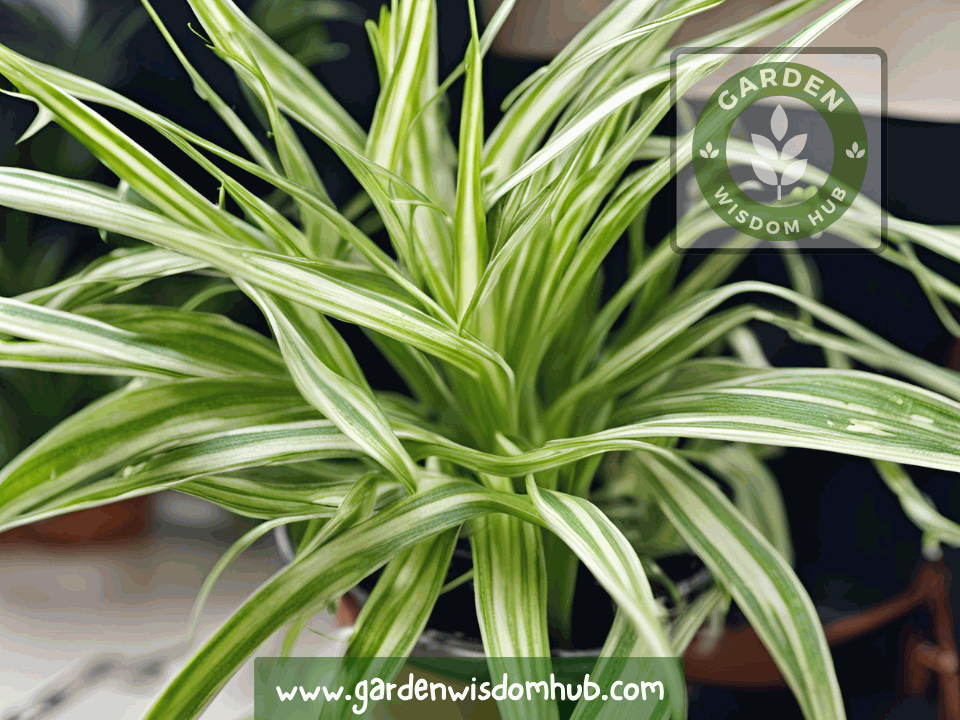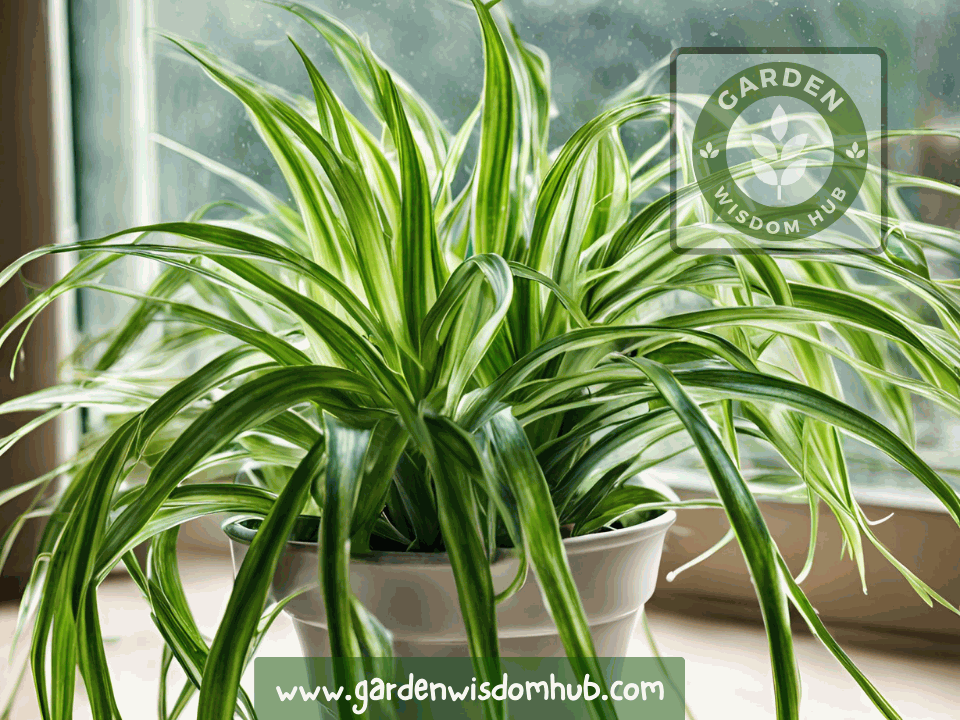Prepare to solve the damp spider plant case! We’ll explain how to recognize an overwatered spider plant, its symptoms, and how to treat it. So, brace up and dive in! If given too much water, the soil doesn’t drain, or the container is too tiny, even the hardest indoor plants, like snake plants, can get into trouble.
Signs of Overwatered Spider Plant:
Are you over-pampering your spider plant? Here are some symptoms you may be drowning in love.
Waterlogged, squishy leaves that droop like a sad puppy should be watched for. If your spider plant is dramatic, it may be yellow and wilt like a soap opera audition. Remember, moderation matters. Too much affection and attention might cause spider plants to show signs of trouble:
Stunted Growth and Yellow Leaves:
Overwatered spider plants will have stunted growth and yellow foliage. The leaves change from green to gold before elegantly falling from their branches.
Waterlogged soil:
Overwatering turns soil into a mushy mess and invites mold. Poor drainage makes the soil moist and spreads fungal infestations like wildfire.
Dark Spots on Leaves:
Those spider plants may have been overwatered. Their leaves may develop black stains. Look at those brown patches. These plant stress signals indicate their roots aren’t feeling well and the soil needs fresh air. Like saying, “Hey, we need some TLC over here!”
Wilting or Curling Leaves:
Overwatering spider plants cause their leaves to droop and curl up like Shakespearean actors. It means “Hey, enough with the H2O, I need a break!” It appears the plant’s roots are in trouble. They may have suffered damage or decay from excessive wetness. Not good for our leafy pal!
Browning of Leaf Edges and Margins:
Your plant may be getting too much water, pal. The leaf edges are yellowing from overexposure to the sun. Stop watering that plant.
Pest Infestation:
Drowning spider plants like fish weakens them and makes them prone to pests. It appears we have unwanted guests in the garden. Pests, including aphids, mealybugs, and whiteflies, feast on weak plants. They’re like insect bullies, picking on the vulnerable. Dear gardener, there are ways to get rid of these pests.
Lean and Dull Appearance:
An overwatered spider plant looks like a wet noodle left out in the rain, frail, lean, and boring as watching paint dry. Look at those droopy leaves! They’re almost touching the ground like they’re in trouble.
Overwatered Spider Plant Treatment:
Explore how to save your spider plant from a watery grave. Reviving an overwatered spider plant is difficult. You’ll need certain strategies to revive that green beauty:
Uproot the plant:
Carefully remove the spider plant from its container. Use a knife to wriggle the soil to make it easier to scoop.
Scrub those roots:
Wash off the dirt and check for decay. Flushing with hydrogen peroxide can eliminate fungus spores. Let’s examine and cut those roots. Check for sneaky root rot and clip infected roots with sanitized shears.
Examine and Trim Affected Roots:
Keep those roots healthy! Remove those rotting roots before they spread their disease.
Change the Digs:
Use a potting mix with sand to create fresh, well-draining soil. Make sure that the new pot is clean, sanitized, and has appropriate drainage holes.
Report in Fresh Soil:
Give the plant some “me time” by placing it in the sun. That should accelerate its recovery.
Proper watering:
Water the plant when the topsoil is bone-dry. Don’t overwater your plants! Let excess water out to give them breathing room.
Can an Overwatered Spider Plant Be Saved?
Do you want to know that a sponge-soaked spider plant will survive? It’s not looking good. It’s like saving a sinking ship after drowning your spider plant. Don’t give up yet. There may be hope. With enough TLC and luck, you could save your wet plant. Roll your sleeves, put on your gardening gloves, and let’s begin. This spider plant is overwatered. We can rescue our green plant with some quick thinking. You thought you drowned your spider plant?
I will guide you through this watery maze. Imagine your spider plant, wet and unhappy like a fish out of water.
How Do I Know If I Overwatered My Spider Plant?

How can you be sure it’s not just a terrible hair day? Try sticking your finger in the soil like you’re checking the water. Overwatering occurs when it feels like a swamp. But if your spider plant is sick, search for these indicators. Look for yellow leaves, soil that feels like a soggy marsh, strange black patches on the leaves, wilting or curled leaves, and a dull and droopy appearance. These indicate that your plant may have taken too many watering can sips!
Do you wonder if an Overwatered Plant Recover? Even if you drown your plant, it can recover with care. If you want your plants to grow, follow these basic principles.
How Do You Save a Dying Spider Plant?
First, don’t overwater them. They require the right quantity, like Goldilocks. And speaking of water, ensure soil drainage. Nobody likes damp roots. Next, give them lots of sunshine. They soak up the light like small sun worshippers. Finally, treat root rot immediately if you see it. Nobody has time for that mess. Following these recommendations will make your plants happier than clams at high tide.
Overwatered vs. Under watered Spider Plant
Avoid drowning the poor thing! Spider plants: When too much affection drowns, or not enough, TLC parches them. It can be difficult to spot an overwatered spider plant, so don’t worry.
Look for these key differences:
You may have overwatered! Yellow leaves, squishy soil, and black blotches may indicate a damp plant. Wilting or curled leaves, brown margins, and bugs indicate concern. Let it rest and dry out. Your plants seem parched! The earth is bone-dry, and the leaves are turning yellow and brown at the tips. Dryness makes them coil up in protest. Though stunted, they can still produce new growth. Give those plants a drink.
How to Revive an Overwatered Spider Plant?
Reviving a damp spider plant is difficult. It’s like teaching a fish to ride a bike! Fear not, my green-thumbed friend, for I have the solution to your soggy problems.
- As a sinking ship, drain that miserable plant. Allow it to dry out after the H2O excess.
- When it’s recovered from finding the truth and cleaning up.
- Now proceed to pruning rotting roots.
- Get your plant some dry dirt.
- Prepare to report! Give it lots of sun. Before watering, make sure the soil is bone-dry.
How to Save Overwatered Spider Plants Indoors
Indoor plants must be monitored. Don’t worry if you unintentionally flooded your spider plant! We have suggestions for saving your green pal from the rain. Put on your gardening gloves, and let’s explore overwatered spider plants!
Can we give those plants less H2O? Make sure the pot drains well, or your plants may drown in their tears! Put the plant somewhere it can get lots of indirect sunlight. Give your plants VIP repotting and root care. Carefully manage those roots like crown gems. Feel free to get your hands filthy and appreciate your origins. Happy roots make happy plants!
How Can I Bring My Spider Plant Back to Life?
Can I revive my spider plant? Reviving a spider plant is difficult! Trying to revive a dying flower is like that. Fear not, my buddy, for I have the secret recipe to revive that neglected plant. Imagine needing water, sunlight, and plenty of TLC, just like giving a green friend CPR. Roll up your sleeves, put on your gardening gloves, and prepare to be magical.
- Recognize and address indicators of over-caring for plants.
- Step up and prepare to pamper your plant.
- Your green companion will feel like a million bucks when we prune and repot.
- Put on your gardening gloves, and let’s begin.
- Avoiding future issues can depend on watering habits.
- It’s time to curb your watering practices to avoid future troubles.
- Explore our article on the Growth Stages Life Cycle & Care Guide to learn more about their growth journey.
How Can You Tell If a Spider Plant Is Overwatered?
Your spider plant may have a tantrum if you give it too much water. Look for yellow foliage, swampy soil, dark stains, withering or curled leaves, and a dull mood. As if to say, “Enough already; I need some breathing room!”
How Do You Save a Spider Plant from Root Rot?
Your spider plant has root rot, huh? Be not afraid, friend! I’ve got the solution. Picture this: We’ll rescue your spider plant from a muddy swamp like a superhero. That unfortunate plant must be removed from its soggy state first. It is time to put on the gardening gloves and shake those roots. Remove any mushy, rotting parts to give the plant a fighting chance. If you wish to save a spider plant from root rot, act immediately.
We must eliminate root rot and give the plant a fighting shot. Don’t let it die like a flower—act now. Shake that plant and clean its roots! Remove those rotting roots. Trim them like a pro gardener. It is a new home for your plant. Prepare to repot in well-draining soil. If the pot has poor drainage, your plants will drown in their tears.
Watch this Video For More Guide: How to Revive an Overwatered Spider Plant
Conclusion:
Make sure your plants have enough water and sunlight. For spider plants, drowning them is like using gasoline to put out a fire. Do not worry! Spider plants can be saved from drowning with a little TLC and common sense. If you want your spider plant to recover from overwatering, recognize the symptoms and treat them. In that manner, your plant will recover and thrive quickly!
To learn more about Vegetable Garden Check out Our Guides:
Types of Spider Plants Exploring the most common top varieties
Spider Plant Care Propagation Tips & Tricks for a Bushier Plant
How Much Water Do Sunflowers Need?
James Porter
Welcome to our haven of gardening and plant care, where outdoor and indoor planting enthusiasts come together! At Gardening Wisdom Hub, we aim to provide you with the most authentic information on anything related to gardening, plant care, seasonal planting etc.
The author of our website is James Porter, an experienced industry veteran. He has a deep interest in everything green. James’s enthusiasm for exploring plants’ features and learning new gardening methods began at a young age. Gradually, his passion increased with time, leading him to become a highly esteemed professional. His extensive knowledge makes him a priceless resource for inexperienced and seasoned gardeners.

